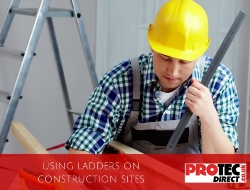When working at height on a construction site for any length of time there will usually be scaffolding provided for health and safety reasons.
However, for both practical, cost and space reasons, there are many occasions when ladders will need to be used on site.
For electricians, painters, carpenters as well as some other smaller jobs required on site, ladders are the only way to access high areas, ceilings, guttering and more.
However, falls are one of the leading causes of workplace injuries and deaths each year, with up to a third of all construction site fall deaths occurring from ladders.
What makes this such a particularly shocking statistic is the fact that falls from ladders are so easily preventable if you follow a basic set of safety principles before using them.
Before using a ladder
You need to evaluate whether a ladder is really the best option for the job at hand. Yes it might be the most convenient and building scaffolding for certain jobs can be expensive and time-consuming but you should never gamble with your or anyone else’s safety.
Ask yourself if you will need to hold heavy items while on a ladder?
Will a long ladder be unstable to use?
Will you be working up the ladder for a long time or will you have to stand sideways on the ladder to carry out the work?
If the answer to any of the above questions is yes, then it may be best to reconsider your options.
You also need to think about what the right kind of ladder for the job is. Do you need a step ladder or rung ladder? Is the ladder going to be long enough for your needs? Or would a folding ladder be more appropriate? Never use ladders that are bent or have rungs missing. You should also check that the spreader bars are in place and in good working order if there is no locking mechanism.
The base of the ladder also needs to be appropriately secured. Never place them on uneven ground or slippy surfaces, and if possible use a securing device. You should also wear the correct footwear too, complete with non-slip soles.
Making sure that you carry out relevant safety checks is another step to take to ensure you’re using a safe ladder or step ladder. Things to check before use include:
Stiles – make sure they’re not bent or damaged
Feet – missing feet or wear/damage to feet could cause the ladder to slip
Rungs – should be in good condition and all present
Locking mechanism – this should work reliably and effectively to lock the ladder in place
Platform – on stepladders, make sure the platform is stable
Ladder PPE
It’s also important to consider what PPE could be useful when scaling a ladder. If you’re climbing particularly high and there’s a risk of falling, using fall arrest equipment is probably a good idea. Other than that, wearing regular PPE such as gloves, boots, and bump caps can protect your extremities from being injured while you’re climbing or descending.
Where you can use a ladder
Because the stability of a ladder is dependent on what type of ground it’s placed on, there are a lot of considerations to make before you decide that it’s the right piece of equipment for the job. You should only ever use a ladder:
- On firm level ground
- On the ground that is clean from debris and liquids
- On a surface that isn’t slippy (whether from oil/grease or a floor coating)
- Where there’s no danger of being hit by vehicles or workers
- Where they’re not blocking windows or doors (make sure to lock or secure windows or doors if this is unavoidable)
- Where the public is too near
- Where it can be secured properly
- While working
Never work on the top rung of the ladder or stand without support. Assume a comfortable and safe position before you start to carry out any of the work. This will involve having three contact points with the ladder at all times.
You should have both feet on the same step of the ladder when you’re working with two hands, using your knees as the third point of contact by pressing them into the step above to anchor yourself.
Don’t carry any tools in your hands while climbing the ladder. Use tool belts or the correct carrying devices to store all tools safely.
The placement of the ladder is also very important. Try not to place it near any doorways or windows that are in use. It might seem like a good set-up for a gag in a sitcom but being knocked off in real life is never funny.
You should also consider the safety of others while working, so create a safe working distance around the ladder and block off routes under, or close by, with visible markings.
Follow all these rules carefully and you will make working on ladders significantly safer. Working at height always carries an element of risk but by minimising this, we can ensure greater safety in the workplace and on-site.





Leave a comment